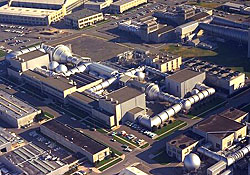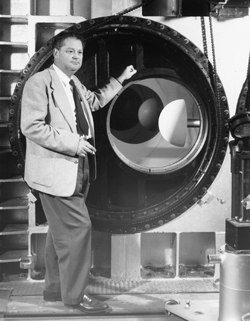
The Unitary Plan Wind Tunnel located at the Ames Research Center at Moffett Field, Sunnyvale, California, was a research facility used extensively to design and test new generations of aircraft, both commercial and military, as well as National Aeronautics and Space Administration (NASA) space vehicles, including the space shuttle. The Unitary Plan Wind Tunnel was created by the National Advisory Committee for Aeronautics (NACA), parent agency of NASA. Constructed between 1950 and 1955, this complex actually contains three wind tunnels. It represents the continual development of superior aeronautical research facilities after the end of the Second World War. These research facilities formed the foundation from which NASA would launch the American effort to land a man on the moon.
After the construction of the Variable Density Wind Tunnel at Langley in 1921, NACA built an impressive variety of technical research facilities upon which the American aircraft industry was based. These facilities enabled the American aircraft industry to dominate the skies in both commercial and military aviation. By 1945, America's lead in the field of aviation seemed to be evaporating. The technological achievements of the German missiles and jet aircraft indicated a lag in American aeronautical research. In 1949, Congress passed the Unitary Plan Act, under which the Federal government coordinated a national plan of facility construction encompassing NACA, as well as the Air Force, private industry and universities. The Unitary Plan resulted in the construction of a new series of wind tunnel complexes to support the American aircraft industry, including the Ames Unitary Plan Wind Tunnel Complex.

Construction of this facility began in 1950-1951 and continued until 1955. Because no one wind tunnel could meet all the demands for additional research facilities simulating the entire range of aircraft and missile flight, NACA chose to build the Ames tunnel with three separate test sections drawing power from a common centralized power plant. The transonic test section spanned 11 by 11 feet, while the two supersonic sections were smaller: nine by seven feet and eight by seven feet. Giant valves 20 feet in diameter supplied air from one supersonic leg to another. The American West Coast aircraft industry quickly capitalized on the Ames Unitary Plan Wind Tunnel Complex. The famed Boeing fleet of commercial transports and the Douglas DC-8, DC-9 and DC-10 were all tested here, as well as military aircraft such as the F-111 fighter, the C-5A transport and the B-1 bomber. In addition to aircraft, in the 1960s and 1970s almost all NASA manned space vehicles including the Space Shuttle were tested in the Ames Unitary Plan Wind Tunnel complex.
The major element of the tunnel complex is its drive system, consisting of four intercoupled electric motors. The transonic wind tunnel is a closed-return, variable density tunnel with a fixed geometry, ventilated throat, and a single-jack flexible nozzle. Airflow is produced by a three-stage, axial-flow compressor powered by four wound-rotor, variable-speed induction motors. For conventional steady-state tests, models are generally supported on a string. A schlieran system, one that allows regions of varying refraction in a transparent medium caused by pressure or temperature differences and detectable by photographing the passage of a beam of light, is available for studying flow patterns, either by direct viewing or by photographs. The details of the larger supersonic tunnel are much the same, except that it is equipped with an asymmetric, sliding-block nozzle and the airflow is produced by an 11 stage, axial-flow compressor powered by four variable-speed, wound-rotor, induction motors. The smaller supersonic tunnel is a closed-return, variable-density tunnel equipped with a symmetrical, flexible-wall throat and the sidewalls are positioned by a series of jacks operated by hydraulic motors.
Visit the National Park Service Travel American Aviation to learn more about Aviation related Historic Sites.
Last updated: August 29, 2017
